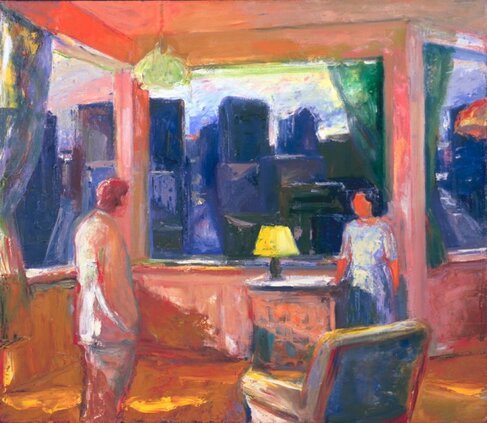|
Connected At the museum today, a young couple stands before a painting called The Yellow Lampshade. The young couple is dressed inconspicuously, in light colours. Their faces are plain. Their very youth provides their colour and aliveness. The painting depicts a couple standing in a corner windowed apartment. A penthouse, I guess you would say. The subjects stand a distance apart. A good stretch of carpet between them and the big windows with all the gray skyscrapers in them. The young couple at the museum is kissing. With deep love, you might say. Sweetly but lingering. I am standing near the painting, closest to the man. My husband stands before the next painting over, closest to the woman. We give them their time – young love is to cherish. And when they move away, he and I come together in front of the painting and kiss, then walk companionably away in opposite directions. In a gray gravel alley shirtless metal workers called puddlers relax, shirtless. They are pale. Spindly. Not mighty workers of the world. Yet their professional was a skilled one. Later, I learn that the job entails continuously working with boiling iron. Puddlers performed strenuous work, very close to the high heat–a job of skill as well as strength and stamina. In the painting, one’s skin is reddened at his clavicle. All of them are arrayed in poses of stretching, reclining and twisting. Poses recalling classic Greek sculptures. The green onion stink of their skin, their unwashed hair and animal restlessness; these are palpable to me. Their male-ness. In their way they are mighty. But the factory behind them looms large. Here’s the third: Modigliani, my favourite painter. This painting depicts a Polish friend of the artist: the poet Pierre-Edouard Baranowski. But I like thinking of the subject as being female. The angular face; the tilted head, the pronounced cupid’s bow. An androgyne in a black jacket and white shirt with the collar loose. The Pole’s eyes are a complete blank. Not blank in that they are white. Rather they are the same blue as the background, which renders the face mask-like. Not unpainted, but rather painted with the effect of being blank. “When I know your soul, I will paint your eyes.” the artist said. In museums these days, I view paintings with a distinct but not unpleasant dizziness: I suffer from vertigo. My husband is always with me. I touch his arm. He squeezes mine, lightly. After 25 years of marriage, he knows what I like. Patricia Quintana Bidar Patricia Quintana Bidar is a native Californian with roots in New Mexico, Utah, and Arizona. She is a former fiction reader for Northwest Review, and alum of the UC Davis graduate writing program. Her stories have appeared or are forthcoming in Wigleaf, The Citron Review, Jellyfish Review, Barren Literary Magazine, Blue Five Notebook, fomercactus, Flash Flood Journal, Train Literary Magazine, Riggwelter Press, and Soft Cartel. In addition to writing fiction, Patricia serves as a writer for national and regional nonprofit organizations. Her Twitter handle is @patriciabidar.
2 Comments
SUSIE FOUGHT
12/15/2019 06:19:35 pm
I remember this one, Patricia. Gives me chills every time.
Reply
Your comment will be posted after it is approved.
Leave a Reply. |
The Ekphrastic Review
COOKIES/PRIVACY
This site uses cookies to deliver your best navigation experience this time and next. Continuing here means you consent to cookies. Thank you. Join us on Facebook:
July 2024
|




